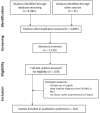What names for covert awareness? A systematic review
- PMID: 35992948
- PMCID: PMC9389234
- DOI: 10.3389/fnhum.2022.971315
What names for covert awareness? A systematic review
Abstract
Background: With the emergence of Brain Computer Interfaces (BCI), clinicians have been facing a new group of patients with severe acquired brain injury who are unable to show any behavioral sign of consciousness but respond to active neuroimaging or electrophysiological paradigms. However, even though well documented, there is still no consensus regarding the nomenclature for this clinical entity.
Objectives: This systematic review aims to 1) identify the terms used to indicate the presence of this entity through the years, and 2) promote an informed discussion regarding the rationale for these names and the best candidates to name this fascinating disorder.
Methods: The Disorders of Consciousness Special Interest Group (DoC SIG) of the International Brain Injury Association (IBIA) launched a search on Pubmed and Google scholar following PRISMA guidelines to collect peer-reviewed articles and reviews on human adults (>18 years) published in English between 2006 and 2021.
Results: The search launched in January 2021 identified 4,089 potentially relevant titles. After screening, 1,126 abstracts were found relevant. Finally, 161 manuscripts were included in our analyses. Only 58% of the manuscripts used a specific name to discuss this clinical entity, among which 32% used several names interchangeably throughout the text. We found 25 different names given to this entity. The five following names were the ones the most frequently used: covert awareness, cognitive motor dissociation, functional locked-in, non-behavioral MCS (MCS*) and higher-order cortex motor dissociation.
Conclusion: Since 2006, there has been no agreement regarding the taxonomy to use for unresponsive patients who are able to respond to active neuroimaging or electrophysiological paradigms. Developing a standard taxonomy is an important goal for future research studies and clinical translation. We recommend a Delphi study in order to build such a consensus.
Keywords: cognitive motor dissociation; consciousness; covert awareness; functional locked-in; minimally conscious state; non-behavioral MCS; unresponsive wakefulness syndrome; vegetative state.
Copyright © 2022 Schnakers, Bauer, Formisano, Noé, Llorens, Lejeune, Farisco, Teixeira, Morrissey, De Marco, Veeramuthu, Ilina, Edlow, Gosseries, Zandalasini, De Bellis, Thibaut and Estraneo.
Conflict of interest statement
The authors declare that the research was conducted in the absence of any commercial or financial relationships that could be construed as a potential conflict of interest.
Figures
References
-
- Bruno M. A., Vanhaudenhuyse A., Thibaut A., Moonen G., Laureys S. (2011). From unresponsive wakefulness to minimally conscious PLUS and functional lockedin syndromes: recent advances in our understanding of disorders of consciousness. J. Neurol. 258, 1373–1384. 10.1007/s00415-011-6114-x - DOI - PubMed



